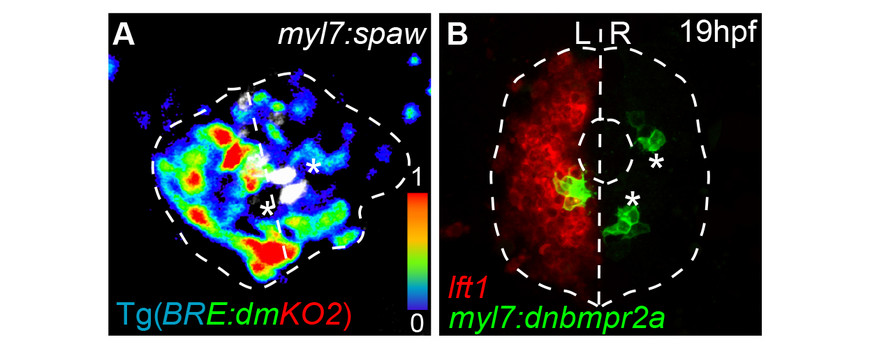Heart morphogen signaling
Signaling by morphogens (=form giving molecules) plays an important role in the regulation of cardiac progenitor cell behaviors. We elucidated the molecular crosstalk between two Transforming Growth Factor-b (TGF-b) morphogens, Nodals and Bone morphogenetic proteins (Bmps), and characterized their impact on left-right asymmetric development of the heart. Our highly-interdisciplinary approach, which included detailed expression analyses combined with functional studies, high-resolution live imaging, and mathematical modeling of this process, suggested that Nodal, via modulating the extracellular matrix within the left cardiac field, dampens the efficiency of Bmp signaling on the left (Veerkamp et al., Developmental Cell 2013). Our findings suggest that minor left-right differences in Bmp activity within the cardiac field may determine bi-phasic states: cardiac progenitor cells within the right cardiac cone are slightly more adhesive, and cells on the left side exhibit a slightly more motile character (Figure 1). Thus, cardiac left-right asymmetry may be explained by Nodal modulating an anti-motogenic Bmp activity. In clonal misexpression studies, in which Bmp activity was clonally reduced within the right cardiac field, we observed an inversion of cardiac laterality. Moreover, reducing Bmp activity to below normal levels on the left side even enhanced cardiac jogging towards the left. One implication of these clonal studies is that changes in individual cell motility rates may impact the tissue displacement of larger coherent groups of cells.
Figure 1: Effect of Nodal on left/right asymmetric Bmp activity within the heart. (A) The transgenic reporter line Tg(BRE:dmKO2)mw40 indicates that the activity of “Bmp”-Smads-1/5/8 is higher within the right compared with the left cardiac field. (B) Reversal of Bmp activity and cardiac laterality upon misexpression of Nodal (Southpaw) within the right cardiac field (asterisks, GFP false-colored in white). Signaling intensities are indicated by color range.

